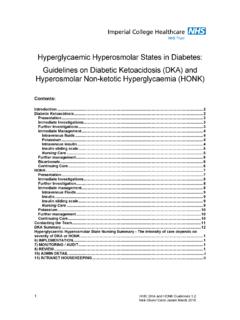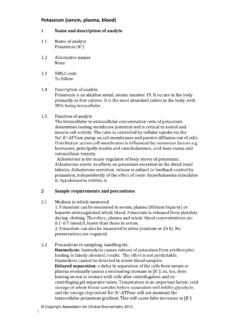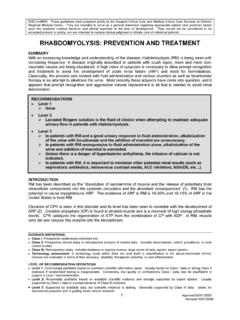Transcription of Baxter Potassium Chloride and 0.9% Sodium Chloride ...
1 Baxter Potassium Chloride and Sodium Chloride Product Information Intravenous Infusion 40mmol/100mL. Baxter Potassium Chloride and Sodium Chloride Intravenous Infusion 40mmol/100mL. Name of the Medicine Potassium Chlorideand Sodium Chloride Composition: the active ingredients are: Potassium Chloride and Sodium Chloride . The chemical names are Potassium Chloride and Sodium Chloride , with chemical formulae as KCI and NaCI, respectively. The CAS numbers are Potassium Chloride 7447-40-7 and Sodium Chloride 7647-14-5. Chemical structure: KCI and NaCI. Description Potassium Chloride and Sodium Chloride occur as colourless or white crystals and are freely soluble in water. The Baxter Potassium Chloride and Sodium Chloride Intravenous Infusion is a sterile, non-pyrogenic solution.
2 The amounts of Potassium Chloride and Sodium Chloride dissolved in Water for Injections are shown in Table 1 (see Presentation). Hydrochloric acid may be added for pH adjustment. They do not contain an antimicrobial agent or added buffer and have a pH of - The product is a hypertonic solution (see Table 1 and Precautions). Pharmacology Mechanism of Action: The Baxter Potassium Chloride and Sodium Chloride Intravenous Infusion is mainly intended for the treatment of Potassium depletion. Thus, the mode of action of these formulations should be looked at from that viewpoint. Potassium is a major cation of the intracellular fluid (160mmol/litre of intracellular water) found primarily in muscle cells. It functions principally in the maintenance of acid-base balance; isotonicity and electrodynamic characteristics of the cells.
3 In contrast, Sodium is the major cation of the extracellular fluid (135. to 145mmol/litre) and functions principally in the control of water distribution, fluid and electrolyte balance and osmotic pressure of body fluids. Na-K-ATPase membrane bound enzymes regulate the passage of Potassium against a higher Potassium concentration in the cells. Potassium participates in carbohydrate utilisation, protein synthesis, and is critical in the regulation of nerve conduction and muscle contraction, particularly in the cardiac muscle. Chloride , the major extracellular anion, closely follows the physiological disposition of Sodium cation in maintenance of acid-base balance, isotonicity and electrodynamic characteristics of the cells. An increase of Chloride concentration may result in a decrease of bicarbonate level, which leads to plasma acidosis, as shown by the charge-neutrality of the cells by the following equation.
4 That is, Na+ = CI + HCO 3 + [anion gap]. , where pH is related to equation, pH = pK H2C03 + log [HCO 3 ]/[ H 2 CO 3 ]. The anion gap is called "unmeasured anion", thus, Baxter Potassium Chloride and Sodium Chloride Intravenous Infusion has a value as a source of water, and electrolytes where kidney may excrete Potassium up to (80 - 90)mmol daily (see Table 1, for Presentation of the products). Daily requirements of Potassium are between 800mg to Pharmacokinetics As Baxter Potassium Chloride and Sodium Chloride Intravenous Infusion is directly administered to the systemic circulation, the bioavailability (absorption) of the active components is complete (100 per cent). From vascular system Potassium ions first enter the extracellular/interstitial fluid, which then are pumped into the cells against concentration gradient by the Na-K-ATPase active transport mechanism.
5 The level of Potassium in the body is regulated by glomerular filtration and distal tubular secretion. Potassium 6 December 2013 Page 1 of 6 Baxter Healthcare Baxter Potassium Chloride and Sodium Chloride Product Information Intravenous Infusion 40mmol/100mL. excretion site is accompanied by Sodium and water reabsorption back into systemic circulation. Thus, kidney constantly adjusts the Sodium and Potassium level through this mechanism. The loss of Sodium can be reduced to zero by increasing Potassium and hydrogen ion excretion. Hormones, ADH (antidiuretic hormone). and aldosterone control the kidney function in reabsorption of water and excretion of Potassium , respectively. The capacity of the kidney to conserve Potassium is poor and some urinary excretion of Potassium continues even when there is severe depletion.
6 Some Potassium is excreted in the faeces and small amounts may be excreted in sweat. Indications The Baxter Potassium Chloride and Sodium Chloride Intravenous Infusion is indicated as a source of water and to restore electrolyte balance as required by the patient's clinical condition, such as hypokalaemia. Contra-indications The Baxter Potassium Chloride and Sodium Chloride Intravenous Infusion is contra-indicated in patients with: - known hypersensitivity to the product - documented hyperkalaemia, hyperchloraemia or hypernatraemia - Potassium retention - congestive heart failure - severe impairment of renal function - acidosis - haemolysis - Addison's disease - in conjunction with Potassium sparing diuretics - clinical states in which the administration of Sodium and Chloride is detrimental Precautions The 40mmol Baxter Potassium Chloride and Sodium Chloride (100mL) infusion is hypertonic.
7 This solution must only be administered: - to patients in high dependency units eg Intensive Care Units or Coronary Care Units under constant ECG. monitoring - Via the lumen of a central venous catheter where the primary solution is typically Sodium Chloride or 5% glucose in water. Monitoring Adequate urine flow must be ensured and careful monitoring of plasma Potassium and other electrolyte concentrations is essential. High dose or high speed infusion must be performed under continuous ECG monitoring. Special warnings . To avoid Potassium intoxication, Baxter Potassium Chloride and Sodium Chloride Intravenous Infusion must not be infused rapidly. Administration should be carried out under regular and careful surveillance. Regular monitoring of clinical status, plasma electrolyte concentrations, plasma creatinine levels, BUN level, acid-base balance and ECG is essential in patients receiving Potassium therapy, particularly those with cardiac or renal impairment.
8 Adequate urine flow should be ensured and fluid balance should be monitored. Potassium salts should be administered with considerable care to patients with cardiac disease or conditions predisposing to hyperkalaemia and/or associated with increased sensitivity to Potassium such as patients with: Renal impairment or adrenocorticol insufficiency acute dehydration extensive tissue destruction such as occurs with severe burns In patients under digitalis therapy, regular monitoring of the plasma Potassium level is mandatory. Potassium -aggravated skeletal muscule channelopathies ( , hyperkalaemic periodic paralysis, paramyotonia congenita, and Potassium -aggravated myotonia/paramyotonia). 6 December 2013 Page 2 of 6 Baxter Healthcare Baxter Potassium Chloride and Sodium Chloride Product Information Intravenous Infusion 40mmol/100mL.
9 Baxter Potassium Chloride and Sodium Chloride Intravenous Infusion should be used with caution to patients who are at risk of experiencing hyperosmolality or undergo correction of alkalosis (conditions associated with a shift of Potassium from intracellular to extracellular space) and patients treated concurrently or recently with agents or products that can cause hyperkalaemia (see Interactions with Other Medicines). Close monitoring, careful dose selection and adjustment is required particularly in high risk patients. Administration of Baxter Potassium Chloride and Sodium Chloride Intravenous Infusion can cause cardiac conduction disorders (including complete heart block) and other cardiac arrhythmias at any time during infusion. Continuous ECG monitoring is performed to aid in the detection of cardiac arrhythmias due to a sudden increase in serum Potassium concentration ( , when Potassium infusion is started) or transient or sustained hyperkalaemia (see Adverse Reactions and Overdosage).
10 Frequently, mild or moderate hyperkalaemia is asymptomatic and may be manifested only by increased serum Potassium concentrations and possibly characteristic ECG changes. However, fatal arrhythmias can develop at any time during hyperkalaemia. Serum Potassium levels are not necessarily indicative of tissue Potassium levels. When infusing Baxter Potassium Chloride and Sodium Chloride Intravenous Infusion; care must be taken to prevent paravenous administration or extravasation because such solutions may be associated with tissue damage, which may be severe and include vascular, nerve and tendon damage, leading to surgical intervention, including amputation. Secondary complications including pulmonary embolism from thrombophlebitis have been reported as a consequence of tissue damage from Potassium Chloride .
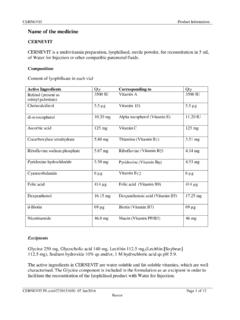
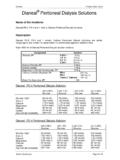
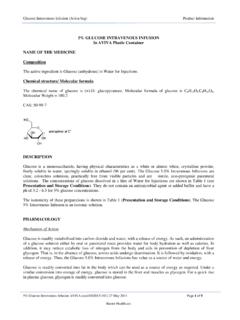




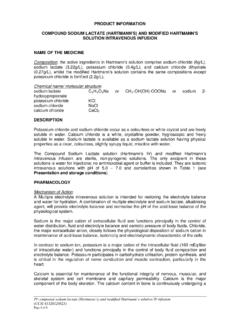
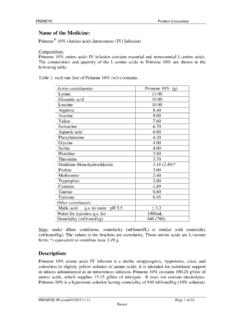
![T I S S E E L [Fibrin Sealant] - Baxter Healthcare](/cache/preview/5/e/c/8/3/b/b/2/thumb-5ec83bb2d349410260af6c556ae67fe3.jpg)



